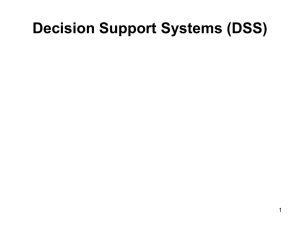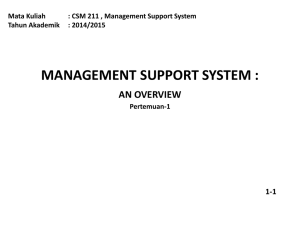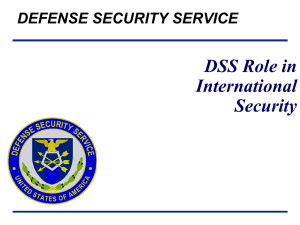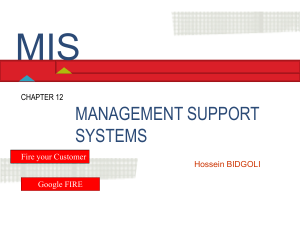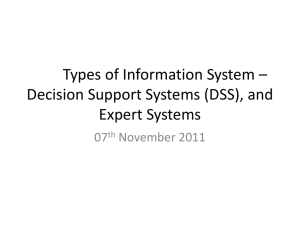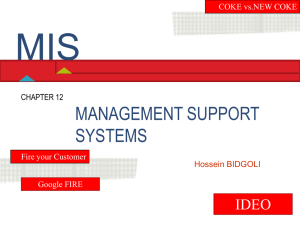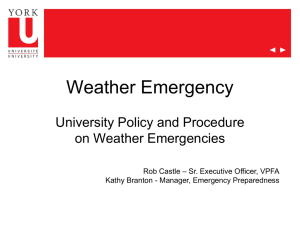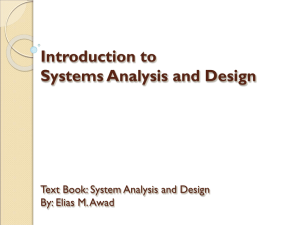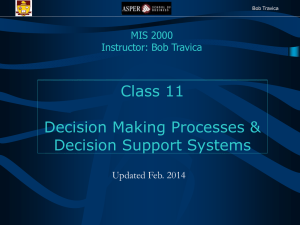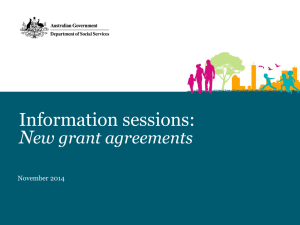Jan Edwards – some thoughts on decision support systems and the
advertisement
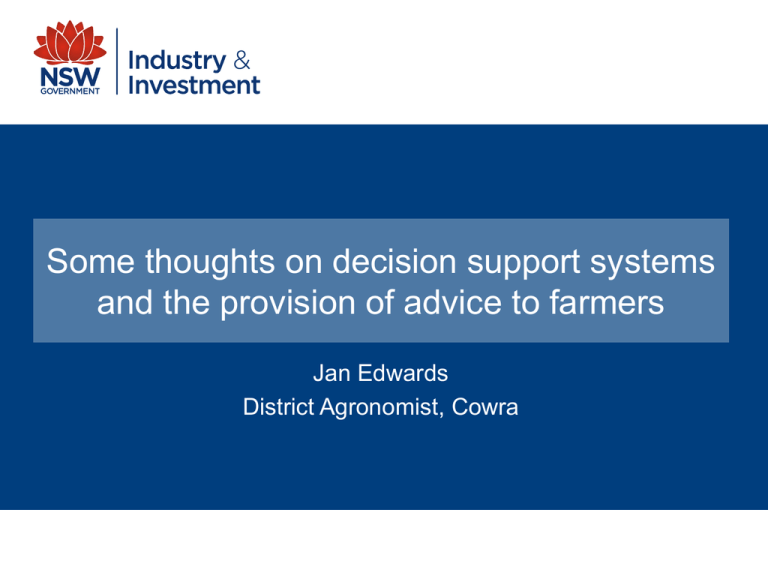
Some thoughts on decision support systems and the provision of advice to farmers Jan Edwards District Agronomist, Cowra GRDC’s premise The advice currently given to farmers by advisers is: – inconsistent – generic (rather than paddock specific) – not the best available – not rigorous enough – more art than science GRDC want to lift the standard of advice Will a decision support tool help: – diagnose why crops aren’t reaching their water limited yield – assist GRDC make research investment decisions. Why would advice differ? Because advisers: – use their training – use past experience – use trial data – extrapolate from experience and data – use rules of thumb – use DSS – use things learnt from training workshops – ask other agronomists – seek help from experts – make educated guesses This makes it individual Is it the only reason outcomes differ? Giving advice is an exchange – Farmers are not the same • age, debt level, family, education • stage of life and family composition are important – Farms are complex partnerships involving many people Decision making is a very human thing – Profit is not necessarily the main driving force – It is also social (not just technical) • A lot of adoption occurs when an idea or practice becomes part of ‘good farm management’ Farmers construct their own knowledge – Scientific advice • is evaluated against other information, knowledge and beliefs • does not automatically have credibility and legitimacy • is used when consistent with their own understanding • is often adapted to fit their own world view Diagnostic agronomy What is the limitation to consistent advice? – Not enough information – Too much information – Confusing information – Not enough time to integrate / summarise information – Not enough strategic, whole farm thinking – Complex situations Diagnostic agronomy requires very effective monitoring – Currently this is done on farm, mostly by farmers, and is very subjective There are only so many things it could be – More likely it is a “combination of factors” – Most of which you don’t need a model to figure out What do you do after the problem is diagnosed? Benchmarking performance We have experience – Collation of data over many seasons and paddocks • Crop production groups • CropCheck database • TopCrop When analysed: – there was rarely a single identifiable reason for good crop performance – ‘rules’ for success were rarely to do with rates and dates • so not easy to transfer Didn’t deal with the ‘so what next?’ question Can decision support systems help? Computer based – Simulation models • GrassGro • APSIM – Predictive models • WheatMan • SowMan – Websites • CropMate – Excel based • Salvaging crops calculator • VarietyChooser Paper based – Rules of thumb • Nitrogen budgeting workshop – References • Wheat growth and development book • Sowing guides • AgFacts GRDC review has identified about 60 DSS Decision making and DSS The promise of DSS – they can organise and process the dazzling volume of crop management information Farming systems are complex DSS tend to be deep but narrow – Models are aimed at biophysical accuracy • at the expense of realism in management? – Also tend to focus on • Tactical decisions (which crop, rates and dates) – numerous, have lesser consequences and lower priorities – less important than strategies? – Rather than: • Operational decisions (sowing, spraying, harvesting) • Strategic (pasture to crop mix, land purchases) Developing DSS They take time and lots of money to develop They need a champion, someone who believes in the concept – The more they believe • the more likely it is to be built • the less likely it is that anyone else will understand its purpose or be as passionate about using it The more they mimic biological systems: – the more data they need – the more complex they are – the harder they are to drive The more complex the easier to create nonsense They need updating or they get old very quickly – they have to have current terminology and/or variety names or people don’t relate to them Using DSS Tools like APSIM are fabulous – they are the only way to handle very complex questions – but without continued basic research they have limitations • row spacing, lupins in NSW, frost, disease ‘Black box’ models put people off – they instinctively want to change a value even if it is not relevant to do so Excel based spreadsheets are more flexible and adaptable Simple systems – to teach you a method or a principle which you then formulate into your own rule of thumb – You don’t have to use it every time you make a decision DSS have a history of failed adoption Farmers make good decisions without DSS Lack of demand for DSS They are built by the people who will use it – Reflect the decision making style of the user – Don’t necessarily match users needs – Users generally not involved in development The analysis is inferior to experienced human judgement – Often no link to what can be done about the situation? DSS focus on operational or tactical decisions They can take a lot of time to learn – Unless they are used often you forget how Tedious data entry Complicated set up process Lack of software support post-release Technical interpretation Need large amounts of input data – some of which the user can’t get easily Lack of computer use for management Time constraints Complex to use Lack of local relevance Poor marketing • Hayman (2002) • Robinson and Freebairn (2000) Precision Models give the illusion of precision – The added precision may make no difference to the decision. – There may be less to be gained from being precisely right with detailed simulation • Especially when you factor in the risk of being precisely wrong It may be better to be vaguely right than precisely wrong to solve the whole problem roughly than part of the problem extremely well • Malcolm (1994) Decision makers are often confronted with situations that are: – Obvious • large response to N fertiliser; or very suboptimal sowing time – Marginal • gain in N fertiliser equal to the cost; or small differences if sown a week earlier or later Better decisions don’t necessarily follow from: – Better information – More information What makes a DSS successful Simple to use Relevant Able to be localised Effective Low cost User-friendly End-users involved in the development Very clear purpose Aimed at learning – Modelling and simulation contribute to learning and knowledge • but there is a weak link between modelling / simulation and change • Robinson and Freebairn (2000) Other options? DSS – More time spent aggregating data – More literature reviews – Publish summarised ‘guides to …’ – Less concentration of trial results, more concentration on updating BMP – More appropriate data management – Better organised website – Rules of thumb – Decision trees – Paper-based tools Consistent advice – Accreditation for agronomists, advisers and consultants – Membership of AACA or similar – Regular re-fresher training – Training for farmers – Less focus on individual trials at the Updates

